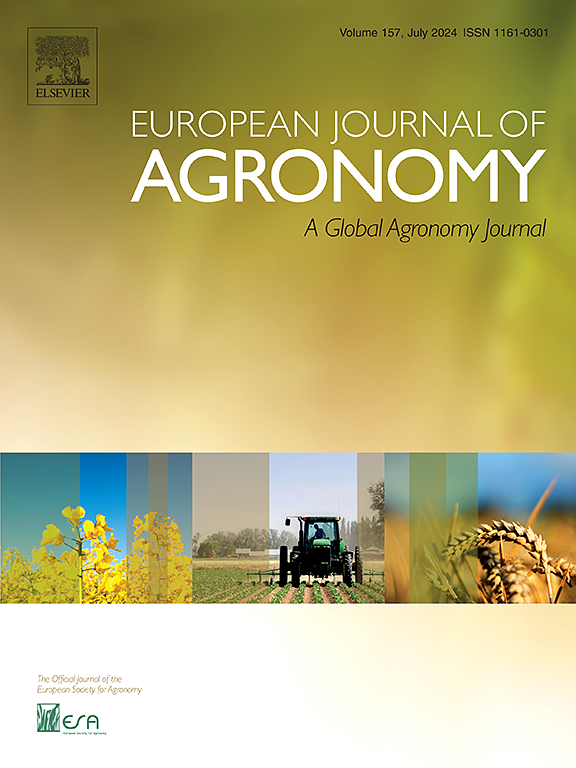推进物联网气生栽培系统中的生菜生理状态识别:元学习驱动的数据融合方法
IF 5.5
1区 农林科学
Q1 AGRONOMY
引用次数: 0
摘要
自动识别植物的关键生理因素,如叶片相对湿度(LRH)、叶绿素含量(Chl)和氮含量(N),对于有效的气生栽培管理以及改善生长、产量、质量和可持续性至关重要。元学习(MetaL)解决方案利用数据融合和智能处理,确保快速、一致的结果。本文旨在开发一种新颖的元学习框架,利用多模态数据源(包括光谱、热和物联网环境数据),实现对气生莴苣中 LRH、Chl 和 N 含量的实时、非侵入式识别。研究从植物特征出发,检查了各种光谱反射指数(SRI)和热指标。利用反向传播神经网络(BPNN)、决策树(DT)和梯度提升机(GBM)实施了基于模型的特征选择,以确定关键属性并优化超参数。实验结果表明,部署基于 GBM 的顶级变量作为基础模型,结合 BPNN 作为元模型,可显著提高分配因子分析的准确性。与单独应用基于 BPNN 特征的独立模型相比,LRH、Chl 和 N 的预测得分(R²)分别提高到 0.875(RMSE=0.879)、0.886(RMSE=0.694)和 0.930(RMSE=0.184)。总之,所设计的方法有助于更准确地预测植物的生理状态,为实现可持续的气生农业迈出积极的一步。本文章由计算机程序翻译,如有差异,请以英文原文为准。
Advancing lettuce physiological state recognition in IoT aeroponic systems: A meta-learning-driven data fusion approach
Automatically identifying key physiological factors in plants, such as leaf relative humidity (LRH), chlorophyll content (Chl), and nitrogen levels (N), is vital for effective aeroponic management and improving growth, yield, quality, and sustainability. Meta-learning (MetaL) solutions utilize data fusion and intelligent processing, ensuring fast and consistent outcomes. This paper aims to develop a novel MetaL framework that leverages multimodal data sources—including spectral, thermal, and IoT environmental data—to enable real-time, non-invasive identification of LRH, Chl, and N content in aeroponically grown lettuce. The research examined various spectral reflectance indices (SRIs) and thermal indicators from plant characteristics. Model-based feature selection was implemented using back-propagation neural networks (BPNN), decision trees (DT), and gradient boosting machines (GBM) to identify key attributes and optimize hyperparameters. The experimental findings indicated that deploying GBM-based top variables as the foundational model, combined with BPNN as the meta-model, significantly improved the accuracy of analyzing the assigned factors. The prediction scores (R²) for LRH, Chl, and N increased to 0.875 (RMSE=0.879), 0.886 (RMSE=0.694), and 0.930 (RMSE=0.184), respectively, compared to applying BPNN-based features alone as a standalone model. Overall, the designed methodology contributes to more accurate predictions of plant physiological states, enabling proactive steps toward sustainable aeroponic agriculture.
求助全文
通过发布文献求助,成功后即可免费获取论文全文。
去求助
来源期刊

European Journal of Agronomy
农林科学-农艺学
CiteScore
8.30
自引率
7.70%
发文量
187
审稿时长
4.5 months
期刊介绍:
The European Journal of Agronomy, the official journal of the European Society for Agronomy, publishes original research papers reporting experimental and theoretical contributions to field-based agronomy and crop science. The journal will consider research at the field level for agricultural, horticultural and tree crops, that uses comprehensive and explanatory approaches. The EJA covers the following topics:
crop physiology
crop production and management including irrigation, fertilization and soil management
agroclimatology and modelling
plant-soil relationships
crop quality and post-harvest physiology
farming and cropping systems
agroecosystems and the environment
crop-weed interactions and management
organic farming
horticultural crops
papers from the European Society for Agronomy bi-annual meetings
In determining the suitability of submitted articles for publication, particular scrutiny is placed on the degree of novelty and significance of the research and the extent to which it adds to existing knowledge in agronomy.
 求助内容:
求助内容: 应助结果提醒方式:
应助结果提醒方式:


